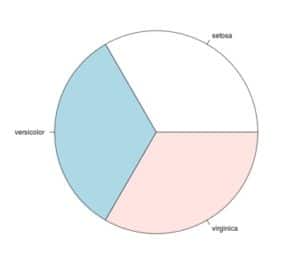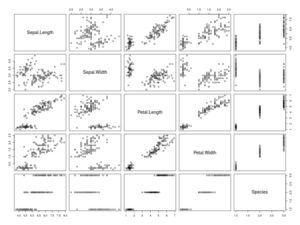Physical Address
304 North Cardinal St.
Dorchester Center, MA 02124
Physical Address
304 North Cardinal St.
Dorchester Center, MA 02124

L’Analisi esplorativa dei dati in R evidenzia, tramite grafici ed indicatori sintetici, le caratteristiche di ciascun attributo presente in un dataset.
Selezioniamo un dataset di esempio tra quelli disponibili nel pacchetto R.
Per avere l’elenco basta digitare:
# elenco dei pacchetti disponibili
data()
Puoi vedere la documentazione di data() per ulteriori dettagli.
In una finestra a parte, si apre un file di testo contenente l’elenco:
Data sets in package ‘datasets’:
AirPassengers Monthly Airline Passenger Numbers 1949-1960
BJsales Sales Data with Leading Indicator
BJsales.lead (BJsales) Sales Data with Leading Indicator
BOD Biochemical Oxygen Demand
CO2 Carbon Dioxide Uptake in Grass Plants
ChickWeight Weight versus age of chicks on different diets
DNase Elisa assay of DNase
EuStockMarkets Daily Closing Prices of Major European Stock Indices, 1991-1998
Formaldehyde Determination of Formaldehyde
HairEyeColor Hair and Eye Color of Statistics Students
Harman23.cor Harman Example 2.3
Harman74.cor Harman Example 7.4
Indometh Pharmacokinetics of Indomethaci
…………………………………..
Prendiamo come esempio il dataset di nome iris. È un dataset multivariato introdotto da Ronald Fisher nel 1936. Consiste in 150 istanze di Iris misurate da Edgar Anderson e classificate secondo tre specie: Iris setosa, Iris virginica e Iris versicolor. Le quattro variabili considerate sono la lunghezza e la larghezza del sepalo e del petalo. A causa di errori, esistono diverse versioni del
dataset utilizzate nella letteratura scientifica.
Con
# maggiori informazioni sul dataset.
help(iris)
Iniziamo l’Analisi esplorativa dei dati in R con alcune funzioni base.
dim(iris)
[1] 150 5
names(iris)
[1] "Sepal.Length" "Sepal.Width" "Petal.Length" "Petal.Width" "Species"
> str(iris)
'data.frame': 150 obs. of 5 variables:
$ Sepal.Length: num 5.1 4.9 4.7 4.6 5 5.4 4.6 5 4.4 4.9 ...
$ Sepal.Width : num 3.5 3 3.2 3.1 3.6 3.9 3.4 3.4 2.9 3.1 ...
$ Petal.Length: num 1.4 1.4 1.3 1.5 1.4 1.7 1.4 1.5 1.4 1.5 ...
$ Petal.Width : num 0.2 0.2 0.2 0.2 0.2 0.4 0.3 0.2 0.2 0.1 ...
$ Species : Factor w/ 3 levels "setosa","versicolor",..: 1 1 1 1 1 1 1 1 1 1 ...
> attributes(iris)
$names
[1] "Sepal.Length" "Sepal.Width" "Petal.Length" "Petal.Width" "Species"
$class
[1] "data.frame"
$row.names
[1] 1 2 3 4 5 6 7 8 9 10 11 12 13 14 15 16 17 18 19 20 21 22 23 24 25 26 27
[28] 28 29 30 31 32 33 34 35 36 37 38 39 40 41 42 43 44 45 46 47 48 49 50 51 52 53 54
[55] 55 56 57 58 59 60 61 62 63 64 65 66 67 68 69 70 71 72 73 74 75 76 77 78 79 80 81
[82] 82 83 84 85 86 87 88 89 90 91 92 93 94 95 96 97 98 99 100 101 102 103 104 105 106 107 108
[109] 109 110 111 112 113 114 115 116 117 118 119 120 121 122 123 124 125 126 127 128 129 130 131 132 133 134 135
[136] 136 137 138 139 140 141 142 143 144 145 146 147 148 149 150
Per mostrase solo le prime 10 righe si usa iris[1:10,].
iris[1:10,]
Sepal.Length Sepal.Width Petal.Length Petal.Width Species
1 5.1 3.5 1.4 0.2 setosa
2 4.9 3.0 1.4 0.2 setosa
3 4.7 3.2 1.3 0.2 setosa
4 4.6 3.1 1.5 0.2 setosa
5 5.0 3.6 1.4 0.2 setosa
6 5.4 3.9 1.7 0.4 setosa
7 4.6 3.4 1.4 0.3 setosa
8 5.0 3.4 1.5 0.2 setosa
9 4.4 2.9 1.4 0.2 setosa
10 4.9 3.1 1.5 0.1 setosa
Solo per la colonna Sepal.Length oppure iris$Sepal.Length[1:10]
iris[1:10, "Sepal.Length"]
[1] 5.1 4.9 4.7 4.6 5.0 5.4 4.6 5.0 4.4 4.9
Distribuzione di ogni variabile abbiamo la funnzione summary().
summary(iris)
Sepal.Length Sepal.Width Petal.Length Petal.Width Species
Min. :4.300 Min. :2.000 Min. :1.000 Min. :0.100 setosa :50
1st Qu.:5.100 1st Qu.:2.800 1st Qu.:1.600 1st Qu.:0.300 versicolor:50
Median :5.800 Median :3.000 Median :4.350 Median :1.300 virginica :50
Mean :5.843 Mean :3.057 Mean :3.758 Mean :1.199
3rd Qu.:6.400 3rd Qu.:3.300 3rd Qu.:5.100 3rd Qu.:1.800
Max. :7.900 Max. :4.400 Max. :6.900 Max. :2.500
Frequenza
table(iris$Species)
setosa versicolor virginica
50 50 50
Varianza
var(iris$Sepal.Length)
[1] 0.6856935
Covarianza tra due variabili
cov(iris$Sepal.Length, iris$Petal.Length)
[1] 1.274315
Correlazione tra due variabili
cor(iris$Sepal.Length, iris$Petal.Length)
[1] 0.8717538
Graficamente abbiamo a disposizone
per un grafico a torta
pie(table(iris$Species))

per un istogramma
hist(iris$Sepal.Length)

per la densità
plot(density(iris$Sepal.Length))

per i Grafici di dispersione
plot(iris$Sepal.Length, iris$Sepal.Width)
per lo scatter plot
plot(iris)
#oppure
pairs(iris)

Guarda tutti i tutorial su Data Management oppure torna su R tutorial.